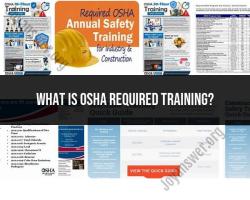How do you become an OSHA trainer?
Becoming an OSHA trainer involves completing specific requirements set by the Occupational Safety and Health Administration (OSHA) and being authorized to deliver OSHA Outreach Training Programs. The OSHA Outreach Training Program provides training to workers and employers on the recognition, avoidance, abatement, and prevention of safety and health hazards in workplaces.
Here is a general pathway to becoming an OSHA trainer:
Professional Experience:
- OSHA typically requires prospective trainers to have professional experience in the safety and health field. This experience helps ensure that trainers have practical knowledge of workplace safety issues.
Education:
- While not always mandatory, having a relevant educational background in occupational safety and health, industrial hygiene, or a related field can enhance your qualifications as an OSHA trainer.
Complete the OSHA 30-Hour General Industry or Construction Course:
- OSHA requires individuals seeking to become trainers to complete the OSHA 30-Hour General Industry or Construction Course. This course provides a comprehensive overview of safety and health hazards in the workplace.
Professional Development:
- Engage in ongoing professional development in the field of occupational safety and health. Staying informed about industry trends, regulations, and best practices is essential for effective training.
Complete the OSHA Trainer Course:
- Attend and successfully complete an OSHA Trainer Course for the specific industry you wish to train in. OSHA offers two main types of Trainer Courses: the OSHA 500 for Construction and the OSHA 501 for General Industry. These courses are typically conducted by OSHA Training Institute Education Centers or authorized OSHA trainers.
Choose a Training Program:
- Decide whether you want to become an Outreach Trainer for General Industry or Construction. Your choice will determine whether you pursue authorization for the OSHA 10-Hour or OSHA 30-Hour Outreach Training Program.
Submit an Application:
- After successfully completing the OSHA Trainer Course, submit an application to become an authorized Outreach Trainer. The application process includes providing information about your qualifications, experience, and training plans.
Maintain Authorization:
- OSHA trainers must maintain their authorization by meeting specific requirements. This may include attending periodic update courses, demonstrating continued professional development, and adhering to OSHA guidelines.
Conduct Outreach Training:
- Once authorized, OSHA trainers can conduct Outreach Training Programs for workers and employers. This includes delivering the OSHA 10-Hour or OSHA 30-Hour courses, depending on their authorization.
Maintain Records:
- Keep accurate records of the training sessions conducted, including participant information and topics covered. This documentation may be subject to review by OSHA.
Stay Informed:
- Stay informed about updates to OSHA standards, regulations, and training requirements. OSHA trainers are expected to incorporate the latest information into their training programs.
It's important to note that the process and requirements for becoming an OSHA trainer may evolve, and it's advisable to check the latest information on the OSHA website or contact an OSHA Training Institute Education Center for the most up-to-date guidance. Additionally, specific state requirements may apply, so be aware of any state-specific regulations related to becoming an OSHA trainer.
What steps are involved in becoming an OSHA trainer?
There are two main pathways to becoming an OSHA trainer: Outreach Training and Authorized Trainer. Here's a breakdown of the steps involved in each:
1. Outreach Training:
- Prerequisites: These are generally less stringent, often requiring a high school diploma and relevant experience in the field of safety and health.
- Training: Complete OSHA's Outreach Trainer Course (e.g., Course #500 for Construction or Course #501 for General Industry). These courses provide foundational knowledge of OSHA standards and regulations relevant to the specific industry.
- Authorization: After successful completion of the training, apply for authorization as an Outreach Trainer with OSHA. This involves submitting an application and supporting documentation, including proof of course completion and relevant experience.
- Responsibilities: Outreach Trainers are authorized to deliver basic safety and health training programs to workers in their industry. These programs cover general topics like hazard communication, respiratory protection, and fall protection.
2. Authorized Trainer:
- Prerequisites: These are more rigorous, typically requiring a bachelor's degree in safety and health or a related field, along with relevant work experience in occupational safety and health.
- Training: Complete OSHA's Trainer Development Course (TDC, Course #300) or an equivalent program approved by OSHA. This intensive course covers advanced training principles and methods for developing and delivering effective safety and health training programs.
- Development and Approval: Develop a specific training program aligned with OSHA standards and regulations for your chosen area of expertise (e.g., confined spaces, welding safety, etc.). Submit the program to OSHA for review and approval.
- Authorization: Once your program is approved, apply for authorization as an Authorized Trainer for that specific program. This involves submitting an application and supporting documentation, including proof of qualifications, program approval, and relevant experience.
- Responsibilities: Authorized Trainers can deliver their approved training programs to workers in their area of expertise. These programs are typically more in-depth and specialized than Outreach Training programs.
Additional Tips:
- Network with other trainers and safety professionals in your industry.
- Stay updated on the latest OSHA standards and regulations.
- Consider pursuing additional certifications or qualifications related to your area of expertise.
- Develop strong communication and presentation skills to effectively deliver training programs.
Resources:
- OSHA Training Institute: https://www.osha.gov/otiec/
- The National Commission for the Certification of Crane Operators (NCCCO): https://www.nccco.org/
- Board of Certified Safety Professionals (BCSP): https://www.bcsp.org/
Becoming an OSHA trainer can be a rewarding career path if you are passionate about workplace safety and health. Choose the pathway that best aligns with your qualifications and career goals, and remember that continuous learning and professional development are crucial for success in this field.
I hope this information helps! Feel free to ask if you have any further questions.







